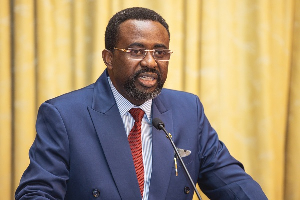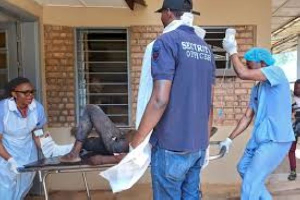• Rice production went up by 29%
• Maize production went up by 5%
• Sorghum and Millet production went up by 20% each
After one year in power, President John Evans Atta Mills has demonstrated in many ways his ability to lead the nation to the ‘promise’ land, with significant improvement on the various sectors of the economy, especially in the agricultural sector.
The Agricultural Sector Performance Index for the year 2009 shows a significant improvement in the sector that holds the key to the country’s development.
Rice production went up by 29% last year, along with maize which clocked a 5% upward move on the previous year’s. Groundnuts and Cowpea saw a 3% growth each in 2009 whilst Sorghum and Millet production went up by 20% each.
Other commodities that witnessed significant increases are 12million tons of cassava, 6million tons of yams, 1.5million tons of cocoyam and 3.6million tons plantain.
In its bid to empower farmers to increase their yield for food sufficiency, the President Mills administration procured 332 agricultural tractors and 63 combined harvesters for distribution to famers across the country on hire-purchase. 17,000 farmers were given starter packs worth $230 each in the form of a grant. About 12,439 farmers including some 8,000 youth were provided with inputs to cultivate 3,236 hectares of maize, 6,935 hectares of rice and 4,015 hectares of soybeans. The Block farm component of the Youth in Agriculture Project (YAP) has been implemented in 6 regions. It has provided employment to some 47,000+ youth.
Over 12,000 hectares of land has been cultivated under the Block farm concept 197,000 metric tons of farm produce is expected from the 12,000 hectares, with 160,000 metric tons coming from maize and which will contribute to the national buffer stock programme. Irrigation of farms for the cultivation of crops also attracted the attention of government which ensured that 34 technicians from 15 private companies were trained in borehole construction. 39 boreholes have also been drilled to irrigate 600 hectares of land in the Ashanti, Central and Greater Accra Regions to promote dry season farming.
Rehabilitation of 72 breached dams/dugouts started in 2009 is 60% complete as at December 2009. 65% of civil works completed at the Small Scale Irrigation Development Project. 85% of work completed at the Small Farm Irrigation Project. Detailed designs of the first 5000 hectares of the Accra Plains Irrigation Project are ready for roll-out in 2010.
Afram Plains District Agricultural Development Project supplied 22 sets of irrigation pumps to vegetable production groups of 503 farmers (including 38% women) from 19 communities. A Buffer Stock Management Agency (BUSMA) has been established, and the Agency is presently involved in mopping up credit given to participants in the YAP Block Farm Concept.
BUSMA is rehabilitating for use, 12 warehouses, some dryers and other facilities of the erstwhile Ghana Food Distribution Company. These were secured from the Divestiture Implementation Committee.
Additionally, the fertiliser subsidy programme was successfully rolled out, providing a 50% subsidy to smallholder farmers.
Livestock development saw an appreciable improvement providing farmers with an opportunity to diversify and add value.
With the assistance of MiDA, farmers in project districts were educated to change their orientation from farming as a way of life to farming as a business.
20,000 sheep and 50,000 goats have been procured for distribution to farmers 25,000 chicks (cockerels) have been brooded and ready for distribution to selected farmers at subsidized prices.
2,132 improved breeds of various livestock were distributed to farmers under the National Livestock Development Project.
The Afram Plains District Agriculture Development Project also distributed 3,700 cockerels to farmers in 38 communities.
235 improved sheep and goats were made available to farmers in 68 communities.
Farmers were trained in animal breed improvement and pasture development.
87 improved animal housing were also made available.
70,000 livestock farmers received various forms of education on farming as a business
In 2010, each district will have at least one agricultural mechanisation centre
Mechanised services will cover a minimum of 241,050 hectares of land in the next 3 years the Youth in Livestock Programme will be implemented, with 12,000 youths expected to be trained in livestock management;
Each youth beneficiary will receive a package of equipment, housing breeding stocks and allowances that will be repayable over a period.
Under the Youth in Fisheries Development Programme, 3,265 youth in 45 districts that will be selected from seven high aquaculture potential regions will be supported to construct fish ponds, develop cage culture and produce fingerlings. The beneficiaries will receive high quality fish feed and fingerlings on credit.
BUSMA will be buying grains to be stored while a number of warehouses and silos will be rehabilitated.
The Irrigation Project will produce about 33,000 metric tons of rice, 6,000 metric tons of maize, 56,775 metric tons of vegetables and 45,000 metric tons of fodder. Over 22,000 unskilled labour will be directly employed over a three year period starting in 2010 on the irrigated lands.
Government will intensify double cropping using existing water bodies in all ten regions: This will enable 16,400 households to produce 302,320 metric tons of vegetables, 44,340 metric tons of rice using about 22,590 hectares of crop land. Over a five year period, the double cropping concept will create employment for some 102,740 unskilled labour over a period of five years.
--------------------------------------------------------------------------------------------------------------------
Work on the 2nd phase of the Tono Irrigation Project and the 72 breached dams will be completed in 2010. The Vea Irrigation Scheme and 30 dams in the Greater Accra and Volta regions will be rehabilitated in 2010.
There are plans to construct and equip two fish laboratories in Accra and Kumasi. Ghana has problems with inadequate good quality fingerlings while the cost of floating feed, which is imported, is very high.
Two fishing harbours will be constructed at James Town and Elmina
Landing sites will be established at Teshie and Ada in the Greater Accra; Axim and Dixcove in the Western Region; Winneba, Mumford, Senya Bereku, Gomoa Fetteh and Moree in the Central Region; Keta in the Volta Region; Dzemeni and Tapa Abotoase on the Volta lake.
Financing discussions are ongoing with Italy.
Construction of 6 cold stores will commence in three regions- Western (Half Assini, New Takoradi, Shama), Central (Kromatse, Nyanyano) and Greater Accra (Prampram).
The road network will also be improved in these areas.
An Agricultural Development & Investment Fund (ADIF) has been advocated for establishment to accelerate the provision of agricultural and fishing inputs, agricultural and fishing related infrastructure and services.
Richard Boafo
Opinions of Saturday, 9 January 2010
Columnist: Boafo, Richard


















